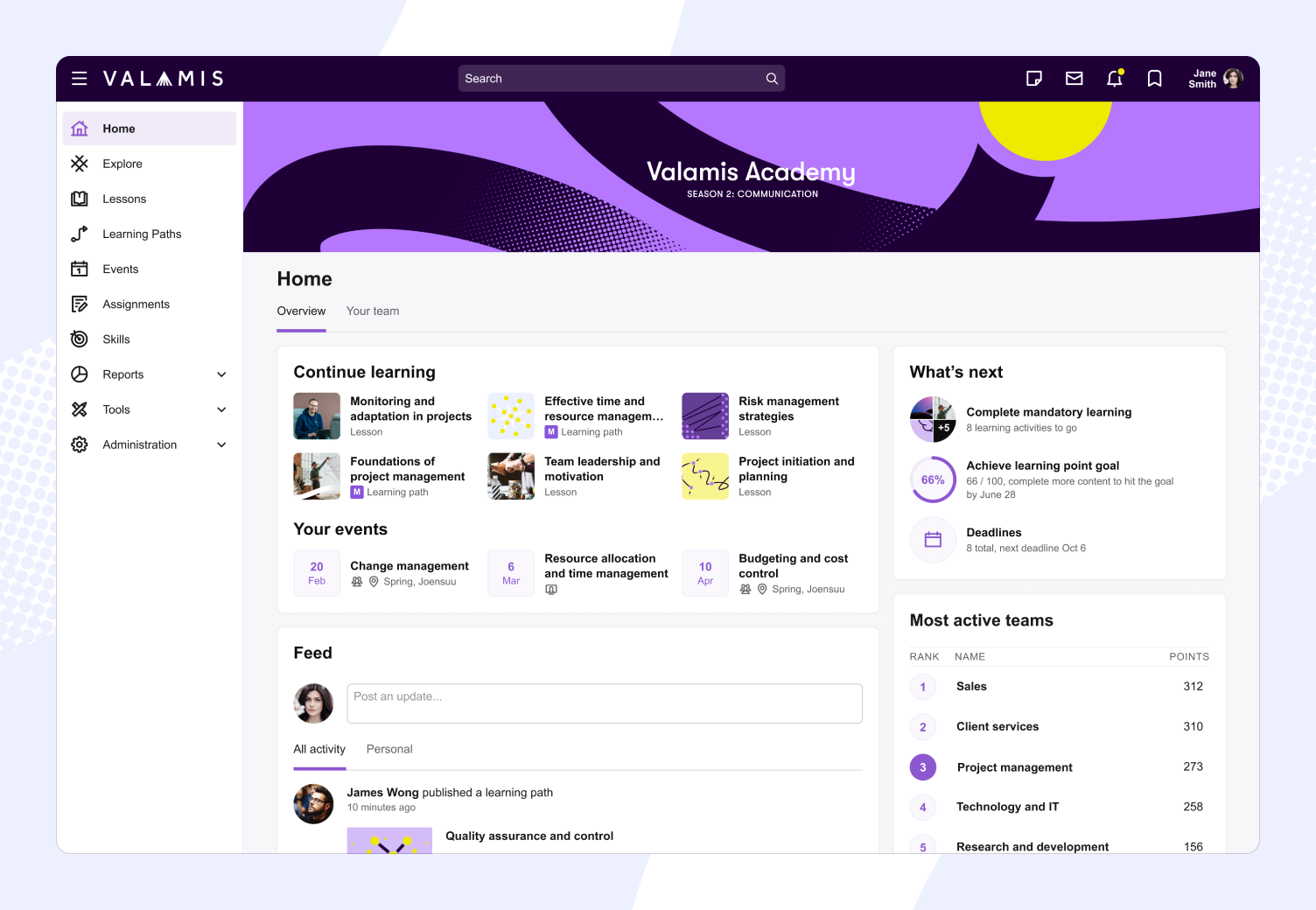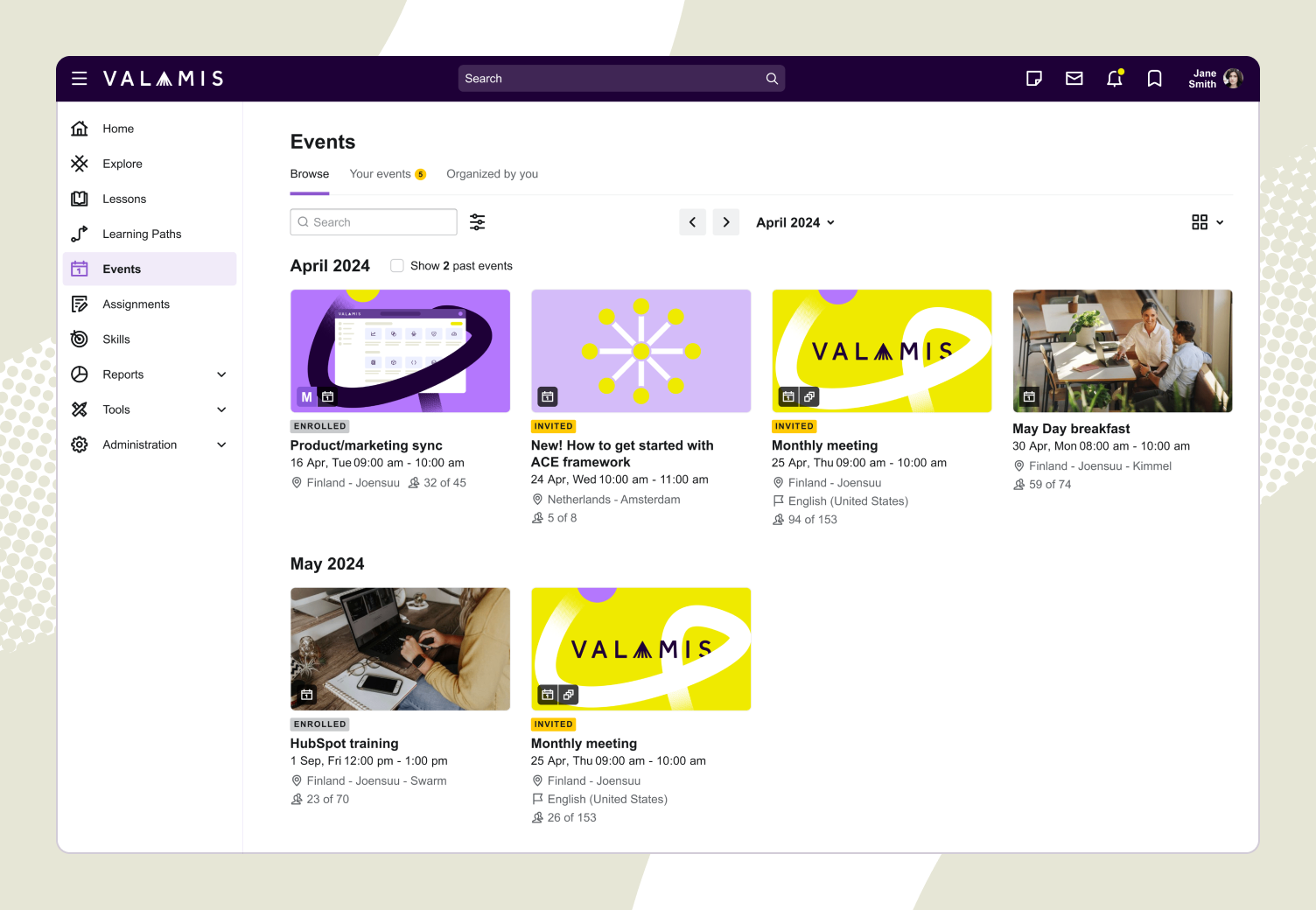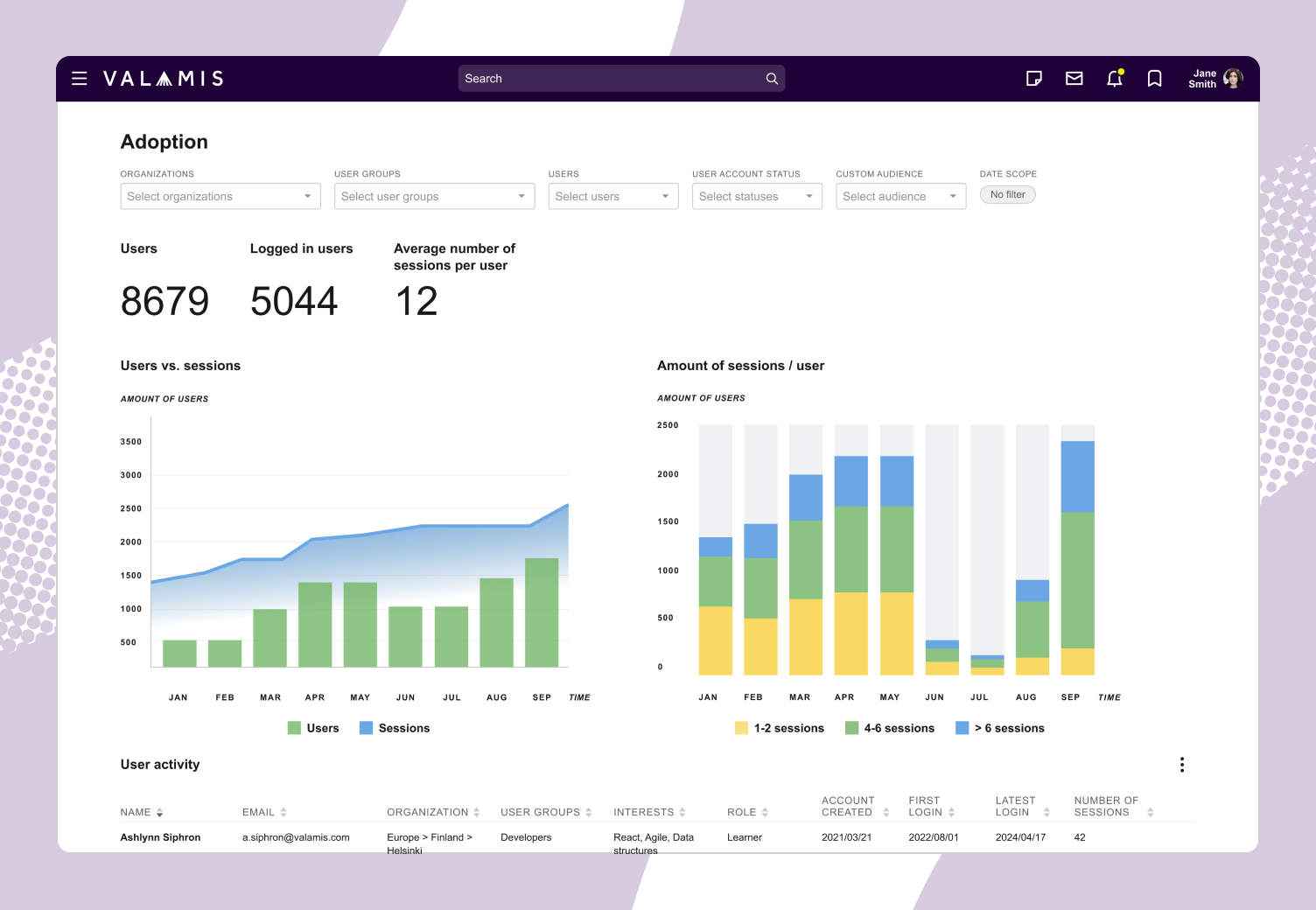Partner onboarding: your key to successful B2B relationships
Streamline your B2B partner onboarding with our comprehensive checklist and process guide. Learn how to onboard new channel partners efficiently.

If you’re in the B2B space, you know that building strong, productive, and lasting partnerships is crucial to success. But to unlock this success, you need a great partner onboarding process that gets both parties on the same page, sets the stage for future interactions, and paves the way for mutual growth.
In this blog, we’ll explore why a well-structured partner onboarding process is essential, common pitfalls to avoid, a step-by-step checklist to follow, and how technology can make the experience seamless. Let’s get started!
- What is partner onboarding?
- Why partner onboarding matters
- Common partner onboarding pitfalls
- Step-by-step partner onboarding checklist
- How to measure and improve partner onboarding success
- Onboarding partners with Valamis
What is partner onboarding?
Partner onboarding is the process of integrating new partners into your business ecosystem. This includes affiliates, resellers, distributors, or any other third-party collaborator.
Think of it as the introduction phase, where partners learn all about your products, services, tools, and policies.
Typical partner onboarding examples include:
- Training on how to use your products or services, following brand guidelines, and interacting with internal teams
- Providing access to the tools and resources needed to make the partnership a success
- Ensuring partners understand and agree to compliance and legal requirements
- Establishing communication channels for future interactions, including ongoing support
- Setting expectations for the partnership and defining the performance metrics by which success will be measured

Onboarding checklist in PDF and Excel formats
Ensure a smooth and effective onboarding process for your new hires and set them up for success.
DownloadWhy partner onboarding matters
With detailed and meaningful partner onboarding processes, everyone understands the working relationship and how to make it a success from day one.
While the majority of time might be spent providing the technical knowledge and expertise to use your products and work with your teams, onboarding also creates a shared mindset and common goals for partners to work towards.
It clarifies operating procedures and prevents misunderstandings. But it also aligns expectations and fosters an environment for seamless collaboration.
Benefits:
Partner onboarding is the foundation from which to build successful B2B collaborations, creating a range of benefits for both sides.
For business:
- Better sales through enhanced partner performance and retention
- Accelerated revenue growth with partners able to start selling products and services faster
- Greater market reach and penetration through integrating new partners
- Consistent branding with partners well-versed in your messaging, values, and standards
For partner:
- Empowering partners through access to the training and resources they need to sell and market your products
- Clearly defined expectations and goals during the onboarding process
- Understanding their opportunities for growth and performance incentives
- Communication channels for support and other resources
Common partner onboarding pitfalls
Onboarding partners is not a simple task, and not all businesses create a process that generates all of these benefits. Common partner onboarding pitfalls to be aware of include:
No clear plan
Without a structured process, partners might feel lost and unsupported. This confusion can lead to frustration and poor performance.
Lack of resources
If your training materials are lacking, partners won’t fully understand your products or services.
Inadequate communication
Miscommunication can lead to misunderstandings and misalignment, which can derail your partnership.
Not taking context into account
Treating every partner the same during onboarding, regardless of their needs and capabilities, leads to operational challenges.
Poorly defined performance metrics
Failing to set clear metrics for partner performance such that they do not know what is expected of them or how they will be evaluated.
These issues can result in disengaged partners and lost opportunities. But don’t worry. We’ve got you covered on how to avoid these pitfalls.
Step-by-step partner onboarding checklist
Want to know what partner onboarding actually looks like in practice? Below is a detailed partner onboarding checklist to help inspire one specific to your business.
Step 1. Onboarding preparation
To onboard partners effectively, first identify the types of businesses you want to collaborate with by creating ideal partner profiles. This helps streamline recruitment and tailor onboarding practices to specific needs, enhancing your chances of success.
Assess the needs of different partners to focus on what matters most in the onboarding process. While tailoring onboarding for each business might be impractical, you can still segment partners based on their working relationships to keep the process relevant.
After understanding partner needs, create an onboarding plan with key milestones, timelines, responsibilities, and training materials. Ensure internal systems and support teams are ready to deliver a seamless onboarding experience.
Step 2. Welcoming new partners
First impressions are crucial, so turn your preparation into a great welcome package to ensure new partnerships start strong. Onboarding new clients involves sharing a lot of information before training even begins, so it’s important to align on partnership goals.
When contacting new partners, deliver essential information without overwhelming them. Provide what they need to stay motivated and take action while ensuring no key details are missed.
A standard first communication should be a welcome email that directs them to additional resources. Include details on the partner program, a timeline for onboarding, and the following:
- Goals, benefits, and incentives of the partner program
- Contact details for key personnel
- Introduction to the partner portal and resource access
- Information on training sessions
- Expectations regarding company values and branding
- Necessary legal or compliance information
Given the amount of information, it’s impossible to cover everything in one email. Instead, provide links to more detailed content on your website or guide them on using the partner portal. Conclude the email by arranging the next step, such as a kick-off meeting or starting partner training.
Step 3. Partner training
The best way to make a partnership successful is to eliminate as many barriers as possible between them signing up and the first sale. For that to be possible, you need an engaging and informative training program that gets them up to speed without wasting time on unnecessary details.
Provide partners with easy access to the training material and support they need. Whether you plan to deliver instructions through live sessions or online content they can access in their own time, ensure you provide actionable and practical content for quick results.

An example of Valamis‘s centralized learning hub to help your partners stay up to date
Provide them with access to a dedicated partner portal. This can be an LMS (Learning Management System) designed to make collaboration and learning easier by acting as a central hub for all their training and resource needs.
Generally speaking, the specific training outcomes you want to achieve can be divided into four categories:
- Product training: A detailed guide to your product or services focusing on the key features, benefits, and differentiators that can close a sale.
- Sales and marketing training: Customer engagement techniques and the marketing material available to attract new leads.
- Systems and tools training: How to interact with your company through the partner portal or other tools.
- Compliance training: All of the legal information required to work with your company, such as data protection or industry regulations.
Training is the core of your onboarding process, where channel partners learn how to work with your company and bring in sales.
Step 4: Prepare and share the tools of the trade
Every quest requires the right gear, and your partners need the tools to succeed—not just to be equipped, but to be equipped to win.
Provide practical and usable content. Ensure that your training and sales materials are clear, actionable, and immediately useful. Partners should have all the information they need at their fingertips.
Supply them with product guides, sales tools, and insider tips from top performers. Think of it as arming them with the best gear before they head into battle.
Offer easy-to-use templates for co-branded marketing materials. Go beyond just providing templates—show them how to personalize these materials, using tools like Valamis’ content authoring tool, to highlight their brand alongside yours.
Step 5. Making a path to success
This step goes beyond partner training to foster a collaborative environment. It includes introducing new partners to the community, providing initial leads, and setting clear expectations.
Publicly introducing new partners—through social media or webinars—helps build awareness and uncover potential synergies, creating new opportunities for both parties.
Offering initial leads at the start gives partners a clear path to their first sale and immediate motivation, while also familiarizing them with your product, systems, and marketing materials.
Setting KPIs and tracking partner performance is essential for aligning expectations and measuring success, closely tied to any incentive programs to drive sales.
Step 6. Ongoing support and partner performance review
Onboarding is never quite finish. You need to continually engage with your partners and provide support to help both businesses grow together.
This includes regular check-ins, meetings, and ensuring a constant dialogue with your partners to uncover any pain points they have.
Tip: You can use an event management tool (example – the event management feature within Valamis), or an Microsoft Teams integration to automate and simplify this. Use these moments to share stories, successes, and even failures, creating a partnership that’s built on continuous learning and adaptation.

An example of Valamis‘s event management tool
Ongoing support also improves the partner experience, leading to greater loyalty and longer-lasting relationships.
Part of this dialogue also includes partner reviews and tracking performance against agreed-upon KPIs.
Tip: Use data from your CRM (Customer Relationship Management), partner portal (like Valamis), and other systems to track metrics that reveal how each partner is really doing.
Step 7. Internal performance review
Finally, you must review your own onboarding performance to review processes for future improvements.
Use KPI data and partner feedback to refine procedures, identify blind spots, and find areas that need work. The best onboarding processes adapt to the evolving needs of your partners and the changing market.
Post-performance review, you may choose to restructure training materials, introduce new support channels, or adapt your marketing material. For example:
- A specific training module may no longer be fit for purpose
- You may need to update sales points based on new product features
- You may find issues with certain training content underperforming
By taking the time to review all of your onboarding processes, you can set your business up for continued success.
How to measure and improve partner onboarding success
Technology is key to measuring and improving partner onboarding processes.
You can provide access to training material and resources and leave partners to get on with it. Or you can actively assess how they interact with this material and look for ways to improve.
Examples include:
Centralized training
Over time, you collect lots of valuable learning content for various roles, departments and purposes.
Some may be used in localized learning solutions. Others may be stored on employees’ computers or hidden in some nameless archive. The same applies to partner content.
Using different platforms for different content or even an outsourced webinar or seminar tool can be a painful experience for new partners.
Using an LMS (or any other learning platform) is an easy and effective way to bring all of your training content together and remove silos.
The easiest way to do this is to migrate, import and revamp your existing training materials using Valamis Studio (Content authoring tool). This setup ensures everyone gets the same quality of training and can revisit materials as needed. It can also serve as a hub for organizing webinars and seminars, which not only makes it a lot more accessible for your partners but also simplifies the organization process for you.
Read: Complete learning solution: 8 benefits of having an all-in-one platform
Automation
No matter how versatile and complex your activities are, some onboarding tasks (sending out welcome emails, scheduling training, etc.) need to be performed every time, regardless of the partner.
Using a modern LMS, you can automate this process without sacrificing personalization to guarantee repetitive tasks are completed efficiently. Automation not only saves time but also ensures consistency, reduces complexity and frees up your team to focus on strategic tasks.
Instead of offering a bunch of materials your new partners have to work through on their own, you can guide them through it, creating tailored learning paths that provide a sense of direction. If your partners feel seen and taken good care of, their motivation to excel will also increase.
Reaching your learners
Streamline content delivery by targeting specific groups like onboarding teams, departments, or dynamic user segments.
Create custom groups based on flexible criteria that automatically update. Simply assign content, and your system ensures it reaches the right people—no manual updates are required.
Track and analyze
After preparing and executing so many steps to properly onboard your partners, you–or your stakeholders–will want to know if the hard work is paying off.
As soon as your onboarding process starts, you have full access to a range of training data. Using modern xAPI tracking, you can:
- Follow up on the onboarding progress and see potential challenges before they become a problem
- Keep tabs on partner engagement and performance metrics
- Quickly spot any issues and provide support where needed.
However, Valamis tracking doesn’t only work for quick responses. It also enables long-term improvements. With xAPI, all activities within your LMS are trackable to provide precise data for insight-filled reports. This even works across teams, departments, or countries in real time, so you can see your overall progress at any given time.

An example of Valamis‘s analytics
Keep an eye on performance metrics and gather feedback from your partners. Tools like Valamis can help track training completion rates, partner satisfaction, and sales performance. Analyzing this data gives you valuable insights into what’s working and what’s not.
Continuous improvement
Always look for ways to improve your onboarding program. Valamis’ reports and data provide detailed insights into individual content pieces. This includes average completion times, common mistakes, and various other details that can help you reveal possible areas of improvement.
Use this feedback and performance data to refine training materials, adjust your communication strategies, and tweak the process as needed. Remember, the goal is to keep evolving to better meet your partners’ needs.
Onboarding partners with Valamis
Onboarding, no matter if it’s internal or external, is a classic task our partners tackle with Valamis. By creating specific and flexible learning paths, our clients make sure that all their information is conveyed effectively and efficiently to maximize the potential of partner programs.
Valamis also uses xAPI-based real-time reporting to help highlight any possible issues and accelerate the onboarding process.
A perfect example of a successful partner onboarding solution is the way Vaillant has done it. Feel free to take a look at how they onboard their field partners in over 16 countries for smooth and seamless operations.
Conclusion
Well-executed partner onboarding processes is your ticket to building strong, successful B2B relationships.
By steering clear of common pitfalls, leveraging technology, and following best practices, you can create an onboarding experience that impresses and empowers your partners. Remember, a strong start sets the stage for a fruitful partnership, leading to shared growth and success.

Onboarding checklist in PDF and Excel formats
Ensure a smooth and effective onboarding process for your new hires and set them up for success.
Download



